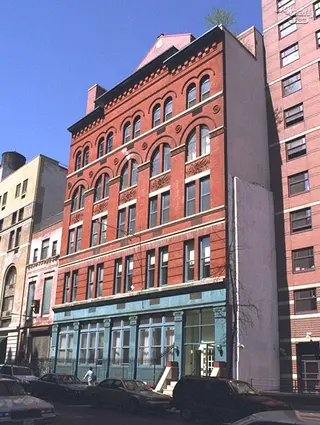 Carter Horsley
Carter HorsleyDec 23, 2011
Carter's Review
This very pleasant, red-brick building was erected in 1900 and converted to a condominium in 1986. The six-story building was 44 apartments.
A rather eclectic Romanesque Revival-style structure, it has a remarkably powerful façade for such a small building. The ground floor has gray-blue retail frontage. The second floor has red-brick rustication, topped by a wide bandcourse. The third floor windows have white stone caps and the fifth floor windows are very large arches divided in two. Interestingly, the red-brick piers between the pairs of windows rises from the third fourth half up the fourth floor where they become the base of the large arches. This architectural ploy is quite successful in lending vertically to this rather squat structure, while also adding considerably visual interest.
The four floor is topped by a thin bandcourse and the fifth floor has small arched windows that are considerably below the building's cornice that has a middle section that rises above and slightly over its wings and is stopped by a pyramidal enclosure.
The building's tight and unusual façade composition expresses great strength, while the arched windows and unusual roofline assert a good degree of elegance and individual, all trademarks of the very high degree of architectural design of commercial buildings in the city in the period between the World's Colombian Exposition of 1983 and prior to World War I.
Located on the north side of the street between Third and Fourth Avenue, this building is close to the Strand Bookstore, Union Square, and Grace Episcopal Church on Broadway and 10th Street.
This neighborhood has many restaurants and boutiques and excellent public transportation.
In the 1940s and early 1950s, this area was famed for its many bookstores and auction houses. Following the renaissance of Union Square due to the completion of Zeckendorf Towers in 1987, the area has undergone a significant upgrading.
While much of the rejuvenation spurred by the Zeckendorf project initially was north of 14th Street, in the late 1990s several major new projects sprang up in the immediately vicinity. One was the angular mixed-use tower on the south side of 14th Street on the west side of Fourth Avenue that featured a movie complex, a huge record store and a very large façade sculpture facing north up Park Avenue South.
Rather quickly and without much fanfare and, surprisingly without much controversy, New York University demolished the Palladium and erected a reasonably attractive new dormitory building adjacent to a new residential midblock complex across from this building known as the Robert F. Kennedy Apartments. The University's expansion in the Village has been phenomenal in the last quarter of the 20th Century and it has marched up Third Avenue with new buildings and its students have enlivened this district dramatically. Fourth Avenue was famous for its bookstores, on which only a handful remain. The Palladium's former use as the Academy of Music reflected the fact that the Academy of Music Opera House originally occupied the site of the Con Edison headquarters tower on the north side of 14th Street at Irving Place and was the city's major opera house until the Metropolitan Opera House opened. The theater at the Academy of Music was a typical large movie palace of its generation and in the 1940's patrons could watch a two features, previews, a cartoon, a newsreel and vaudeville acts for 25 cents a ticket. The largest theater in the Village, it was also the only one with live entertainment, although in its later years it did away with the vaudeville acts.
Isozaki's tranformation of the old Academy of Music theater was sensational and absolutely worthy of landmark designation, but none was forthcoming and indeed may not even have been considered. Adjacent to the theater was Julian's Academy, one of the city's oldest and most famous billiard parlors.
Luchow's, of course, was one of the city's most famous culinary landmarks and largest restaurants and its demise reflected the collapse of the Union Square area in the 1950s as it became a haven for drug pushers and users.
While the Palladium and Luchow's had relatively distinguished celebrity, Union Square was dominated for decades for S. Klein's-on-the-Square, a sprawling discount department store that anchored the extensive street-front retail activity along 14th Street that catered to many travelers on the many subway lines that crossed at Union Square.
Today, Union Square is the anchor to the Midtown South district and its area overlaps with that of the "Flatiron" district just to the north and both are remarkably vibrant with many trendy restaurants, boutiques and high-end retailers.
This area of the Village is a very interesting mix of superb early commercial buildings, some fine pre-war apartment buildings, some large post-war apartment buildings, a bowling alley, and several of the city's finest churches, architecturally.
Whereas the best blocks of the Village were for decades considered to be on the west side of Fifth Avenue, the renaissance of Union Square and the Flatiron District have led to the rediscovery of this neighborhood that was once rather quiet, but now is very lively.
Carter B. Horsley

- Condo built in 1930
- Converted in 1989
- 1 apartment currently for sale ($2.8M)
- Located in East Village
- 44 total apartments 44 total apartments
- 10 recent sales ($1.2M to $5.8M)
- Doorman
 6sqft delivers the latest on real estate, architecture, and design, straight from New York City.
6sqft delivers the latest on real estate, architecture, and design, straight from New York City.
